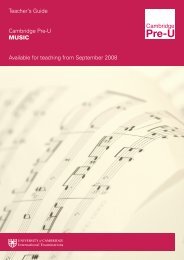Cambridge Pre-U Syllabus - Cambridge International Examinations
Cambridge Pre-U Syllabus - Cambridge International Examinations
Cambridge Pre-U Syllabus - Cambridge International Examinations
Create successful ePaper yourself
Turn your PDF publications into a flip-book with our unique Google optimized e-Paper software.
<strong>Cambridge</strong> <strong>Pre</strong>-U <strong>Syllabus</strong><br />
Appendix 3: Mathematical requirements<br />
Candidates should be able to:<br />
• recognise and use expressions in decimal and standard form<br />
• use a calculator for addition, subtraction, multiplication and division, finding the arithmetical mean and to<br />
find and use x 2 1<br />
, , x , log10x<br />
x<br />
• take account of accuracy in numerical work and handle calculations so that significant figures are<br />
neither lost unnecessarily nor carried beyond what is justified<br />
• make estimations of the results of calculations (without using a calculator)<br />
• recognise and use ratios<br />
• correctly calculate percentages and express changes or errors as percentages and vice versa<br />
• comprehend and use the symbols , ∆, ≈, /, ∝, Σ<br />
• calculate areas of right-angled and isosceles triangles, circumference and area of circles, areas and<br />
volumes of rectangular blocks and cylinders<br />
• translate information between graphical, numerical, and algebraic forms<br />
• construct and interpret frequency distributions and diagrams, pie charts and histograms<br />
• select appropriate variables and scales for graph plotting using standard 2mm square graph paper<br />
• for linear graphs, calculate the rate of change<br />
• recognise when it is appropriate to join the points with straight ruled lines and when it is appropriate to<br />
use a line (straight or curved) of best fit<br />
• choose, by inspection, a line (straight or curved) which will serve as the best line through a set of data<br />
points presented graphically<br />
• understand, draw and use the slope of a tangent to a curve as a means to obtain the rate of change<br />
• understand and use the prefixes: giga (G), mega (M), kilo (k), milli (m), micro (µ), and nano (n).<br />
• have sufficient understanding of probability to understand genetic ratios<br />
• understand the principles of sampling as applied to biological situations and data<br />
• understand the importance of chance when interpreting data<br />
• use a spreadsheet program for collating, analysing and presenting data<br />
• calculate standard deviation and standard error<br />
• understand the benefits of using standard error and 95% confidence intervals (95%CI) to make<br />
statements about data and to use as error bars on graphs<br />
• understand the difference between correlation and causation; use Spearman’s rank and Pearson’s<br />
linear correlation to test for correlation<br />
• use the χ 2 test and the t-test<br />
63

















